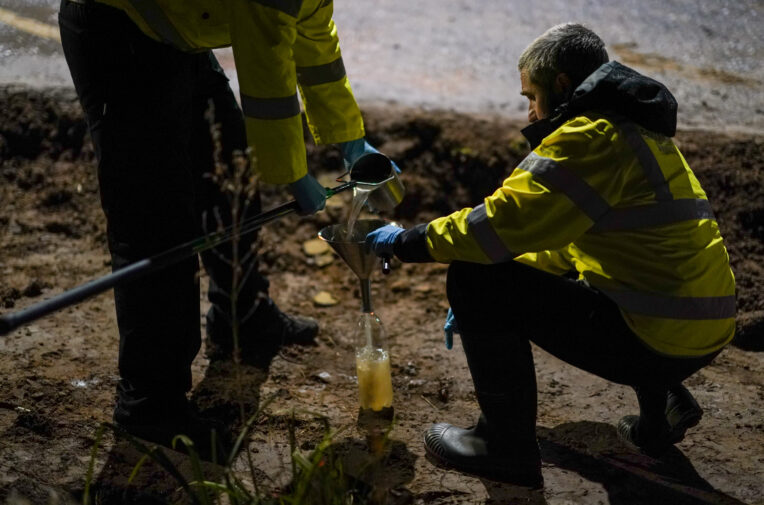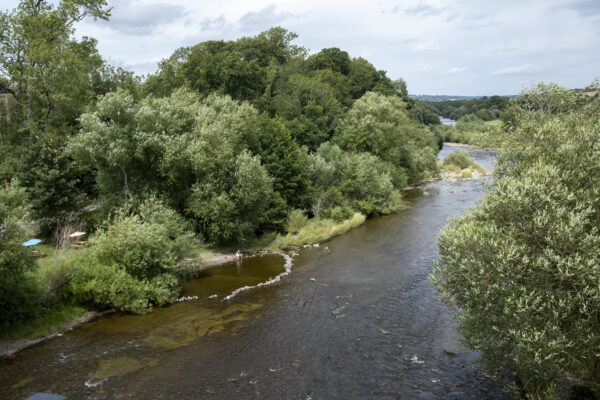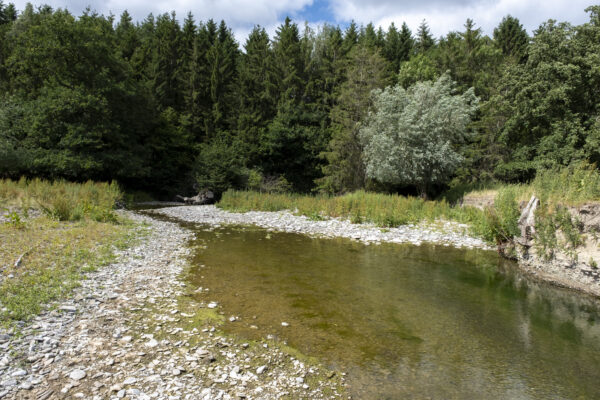
Environment Agency staff take a water sample at a ruptured sewage pipe in Saltburn-by-the-Sea. Photo: Ian Forsyth/Getty Images
Staff shortages have forced major cuts to Environment Agency water quality monitoring, internal documents reveal
Conservationists warn that cancellation of thousands of tests since May will leave a “regulatory and ecological blind spot”
Staff shortages have forced major cuts to Environment Agency water quality monitoring, internal documents reveal
Conservationists warn that cancellation of thousands of tests since May will leave a “regulatory and ecological blind spot”
Environment Agency staff take a water sample at a ruptured sewage pipe in Saltburn-by-the-Sea. Photo: Ian Forsyth/Getty Images
The Environment Agency (EA) has dropped 10,000 water quality tests from its work to ensure the health of England’s rivers and lakes over the past three months, due to staff shortages at the regulator’s main lab.
The agency took a last-minute decision to pause or cancel the tests in spring, a joint investigation by Unearthed and DeSmog has found.
A manager at the environmental regulator emailed colleagues in late March to say the plan was to pause “inorganic” water quality testing in its “entirety” for 10 national programmes, documents obtained under freedom of information laws show. A further five programmes faced a partial pause.
Monitoring during a drought is vital to gauge whether protective measures like hosepipe bans are effective enough
– Ali Morse, water policy manager, The Wildlife Trusts
This pause has run from May into July, and has hit programmes including those that track chemical pollution in rivers, lakes and estuaries, and another that monitors the regulator’s local responses to drought. While this testing has been on hold, five English regions have officially gone into drought, after the “driest spring in 132 years”.
Janina Gray, deputy chief executive of the conservation charity Wildfish, said the loss of this testing was “not just a data gap; it’s a regulatory and ecological blind spot.”
“Routine water quality monitoring is the backbone of environmental protection,” Gray told Unearthed and DeSmog. “Cutting this data will undermine the ability to detect pollution, enforce environmental regulations, and protect biodiversity.”
The sudden cuts came after a “significant number” of staff left the “inorganics” team at the EA’s Starcross laboratory in Devon, with “further staff signalling their intention to depart,” according to emails obtained under freedom of information laws.
This is the team responsible for testing EA water samples for compounds like nitrates and phosphates, which are critical measures of the impact of pollutants like sewage, as well as a host of other important water quality tests.
In addition to the pause imposed on some national monitoring programmes, local EA teams have also seen cutbacks to the tests they commissioned from this lab, Unearthed and DeSmog have learned.
Documents show that the work affected by these cuts included investigations into the water industry in various parts of the country, as well as monitoring of protected areas like the River Wye, which is currently facing a pollution crisis linked to industrial farming.
This is the second year in a row that the agency’s water quality monitoring programmes have been hit by a shortage of capacity at its main lab, internal emails show. “This is not a dissimilar position to that which we found ourselves in last year,” wrote one senior manager. She added: “Apologies – I know this isn’t where we want to be (again).”

An EA spokesperson said water quality testing remained a “top priority”, and had recently received an £8m funding boost from the agency.
“Our water quality testing programme remains robust and prioritised on the basis of need – only a small proportion of tests were impacted by this issue, with no impact on pollution incidents and bathing water testing,” she added.
“As with any large organisation, fluctuations in staffing capacity are to be expected. We are currently investing in extra staff to manage this.”
I know that no one including me wants to see this monitoring delivery reduce
– Environment Agency Manager, internal email, March 2025
The EA said it had been able to reduce the impact of the staff shortage by postponing the collection of some samples until later this year, or until 2026. It had further reduced the impact by a process of “optimisation”, in which the agency looks for opportunities to reduce the amount of testing needed by using single test results to provide data for multiple monitoring programmes.
However, it confirmed that around 10,000 tests had been paused or cancelled over the period May-July, while 47,000 remained in place.
The agency emphasised that this was a major improvement compared to the initial estimates of the impact that EA managers had made in March and April. However, it was unable to confirm how many national programmes did ultimately face a complete pause in inorganic testing, despite repeated requests.
The agency is currently recruiting staff to fill gaps in the inorganics team, but is not yet at full capacity. It aims to halve the number of paused tests by August, and return to the full testing programme as soon as possible. It says it has almost finished filling its current vacancies. It is also planning to expand the size of the team, from 26 full time equivalents to 30, by the end of September, in a bid to make it more resilient.
A spokesperson for the Department for Environment, Food and Rural Affairs said: “This government is cleaning up our rivers, lakes and seas for good – backed by record funding for enforcement, paid for by the water companies responsible for it.”
The news comes after environment secretary Steve Reed announced this week that there would be a new water regulator that takes over the water related duties of the EA and Natural England, as well as the responsibilities of Ofwat and the Drinking Water Inspectorate. Under the plans, issued in response to a review of the water sector released on Monday, Ofwat is set to be completely abolished.
A ‘gaping hole’ in our understanding
Inorganic chemistry is focused on chemicals that do not contain carbon. The ‘inorganics’ team at Starcross analyses EA water samples for non-carbon-based compounds like nitrates, phosphates and ammonia, as well as other important indicators of water quality, including chlorophyll, pH and dissolved solids.
Nitrates and phosphates are plant nutrients that are present in animal and human waste, as well as artificial fertilisers. Nutrient pollution from sewage, fertilisers and manure is having major impacts on rivers and lakes across the country by causing the rapid growth of algae that can drain water of the oxygen vital to aquatic life.
EA spreadsheets obtained under FOI rules show that tests to analyse the level of these nutrients in water were one of the main areas of inorganic work earmarked for cutbacks.
The regulator also planned significant cuts to tests for “biochemical oxygen demand”, a key measure of water pollution, and of a waterway’s capacity to support fish and other aquatic animals.
Jo Bradley, a former EA officer who is now the director of operations at anti-pollution charity Stormwater Shepherds, told Unearthed and DeSmog that failing to test river water quality for inorganic substances “leaves a gaping hole in our understanding of river health and weakens any endeavours to pinpoint sources of pollution and to control polluting discharges”.
She added: “These substances must be tested routinely, at many hundreds of locations, so that we can see trends in river chemistry and quickly identify problems.”
Among the programmes that faced cuts to these tests was “end of pipe” testing for “discharge compliance”. This programme conducts tests on water samples to ensure water companies and other regulated businesses that discharge pollutants into waterways are complying with the terms of their permits.

The regulator also targeted cuts to testing for two different national programmes that monitor and manage the impact of drought. In May, less than a month after the pause came into effect, the EA declared a drought in the North West. Since then, a further three English regions have gone into drought.
Ali Morse, water policy manager at The Wildlife Trusts told Unearthed and DeSmog, that failure to monitor the impact of measures to tackle drought could leave England poorly prepared.
“With less water in the channel, pollutants are more concentrated, so monitoring during a drought is vital to gauge whether protective measures like hosepipe bans and public campaigns about saving water are effective enough, or whether they need to be ramped up,” Morse said.
On top of the cuts to national programmes, local EA teams were told they would have to halve the amount of samples they sent to the inorganics team between May and July.
“I know that no one including me wants to see this monitoring delivery reduce”, one senior staff member wrote in the emails in March.
An EA spokesperson told Unearthed and DeSmog that the suggestion local testing would have to be halved was an initial estimate, and the agency had been able to significantly reduce the impact through “optimisation” and postponing some sampling. However, they were unable to say what percentage of local tests were actually cut.
Emails and planning documents indicate that most regions of England were affected by these cuts to locally commissioned testing.
In a 17 April email, a manager listed work that would be affected by the cuts ranging from water industry investigations in Lincolnshire and Northamptonshire, to investigations into unsustainable levels of water abstraction in the North West, to monitoring of protected conservation areas including the River Wye.
The River Wye – a designated site of special scientific interest (SSSI) and Special Area of Conservation’ (SAC) – is currently facing a pollution crisis widely blamed on the intensive poultry industry in the area. An assessment of the ecological status of the Wye last year found that the ecological conditions of the river dropped from “unfavourable – recovering” to “unfavourable – declining” as a result of pollution from phosphates, nitrates and ammonia.
In the Solent and South Downs, home to a variety of coastal habitats, cuts were planned to the monitoring of Special Areas of Conservation (SAC) and Special Protection Areas (SPA).
In Hertfordshire and North London, the EA also targeted cuts to tests monitoring “Water body deteriorations & investigations – Crane, Brent & Thames”. The cuts follow an outcry in November, after local campaign groups revealed that seven blocks of flats in London had been discharging untreated sewage directly into the Crane and Brent rivers, which flow into the River Thames.
Another site included in the planned cuts was the River Linnet, one of just over 200 chalk streams worldwide, 85 percent of which are found in England. Documents show that testing for an “Investigation of elevated ammonia & phosphate levels in R[iver]. Linnet” was targeted to be paused in East Anglia. Chalk streams like the Linnet – which usually have extremely pure water, making them a rare habitat to plants and animals – are particularly sensitive to ammonia and phosphate pollution from agricultural runoff, due to their naturally low nutrient-levels.
Dr Janina Gray at Wildfish said that the cuts meant pollution events “may go unnoticed until serious damage has occurred.”
Despite cuts across the rest of the UK, the EA decided to maintain monitoring in the Lake District. “Discharge compliance in [the] Cumbria & Lancashire Area is not affected to ensure sampling of all discharges into Windermere continues.” The government vowed in March to “clean up Windermere”, following the launch of a major campaign in 2021 after it was revealed that 7,000 hours of untreated sewage had flowed into the lake during the previous year.




